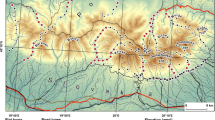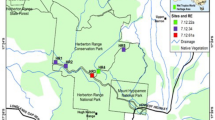Abstract
The spread of alien plant species by vehicles profoundly affects the roadside vegetation. Roads with high traffic densities in urban regions may facilitate the invasion of alien plants. The present study examined the effects of road type and distance to the city centre on native and alien plant species in both the aboveground vegetation and soil seed bank of road verges in originally dry steppe grasslands in the surroundings of Pavlodar, Western Siberia, Kazakhstan. This region is characterized by a recent change of land use and rapidly expanding urbanization. Vegetation surveys were conducted at 12 sites distributed along roads with different traffic densities (national and local roads) and at two distances to the city centre (city edge and rural surroundings). The seedling-emergence method was used to examine the soil seed bank at each site. We found a larger percentage of alien species along national roads (42 % in the aboveground vegetation, 57 % in the soil seed bank) than along local roads (20 and 44 %, respectively), which can be explained by differences in traffic density, location from which the vehicles come and habitat conditions. More alien species were found in the road verges at the city edge than in the rural surroundings along both road types, probably due to the spread of propagules from residential areas. Our study demonstrates that national roads are important pathways for the introduction of alien species in this Western Siberian region.




Similar content being viewed by others
References
Anderson MJ (2005) PERMANOVA: a FORTRAN computer program for permutational multivariate analysis of variance. Department of Statistics, University of Auckland, Auckland
Angold PG (1997) The impact of a road upon adjacent heathland vegetation: effects on plant species composition. J Appl Ecol 34:409–417
Ansong M, Pickering C (2013) Are weeds hitchhiking a ride on your car? A systematic review of seed dispersal on cars. PLoS One 8(11):e:80275
Arévalo JR, Otto R, Escudero C, Fernández-Lugo S, Arteaga M, Delgado JD, Fernández-Palacios JM (2010) Do anthropogenic corridors homogenize plant communities at a local scale? A case studied in Tenerife (Canary Islands). Plant Ecol 209:23–35
Auffret AG, Cousins SAO (2013) Grassland connectivity by motor vehicles and grazing livestock. Ecography 36:1150–1157
Braun-Blanquet J (1964) Pflanzensoziologie: Grundzüge der Vegetationskunde. Springer, New York
Christen D, Matlack G (2006) The role of roadsides in plant invasions: a demographic approach. Conserv Biol 20:385–391
Cole DN (1995) Experimental trampling of vegetation. II. Predictors of resistance and resilience. J Appl Ecol 32:215–224
Committee of Statistics of the Republic of Kazakhstan (2015) Pavlodar region. http://www.stat.gov.kz/faces/homePage.htm
Crawley MJ (2013) The R book, 2nd edn. Wiley, Chichester
Czerepanov SK (1995) Plantae Vasculares Rossicae et Civitatum Collimitanearum (in limicis USSR olim) (list of vascular plants of Russia and adjacent states (in the limits of former USSR)). Mir I Semia, St. Petersburg
Dufrêne M, Legendre L (1997) Species assemblages and indicator species: the need for a flexible asymmetric approach. Ecol Monogr 67:345–366
Fischer SF, Poschlod P, Beinlich B (1996) Experimental studies on the dispersal of plants and animals on sheep in calcareous grasslands. J Appl Ecol 33:1206–1222
Fisher JL, Loneragan WA, Dixon K, Veneklaas EJ (2009) Soil seed bank compositional change constrains biodiversity in an invaded species-rich woodland. Biol Conserv 142:256–269
Fowler JF, Sieg CH, Dickson BG, Saab V (2008) Exotic plant species diversity: influence of roads and prescribed fire in Arizona ponderosa pine forests. Rangeland Ecol Manag 61:284–293
Goloskokov VP (1972) Иллюcтpиpoвaнный oпpeдeлитeль pacтeний Кaзaxcтaнa (Illustrated keys to plants of Kazakhstan). V. 1-2. Alma-Ata - Nauka of Kazakh SSR
Hayasaka D, Akasaka M, Miyauchi D, Box EO, Uchida T (2012) Qualitative variation in roadside weed vegetation along an urban–rural road gradient. Flora 207:126–132
Hodkinson DJ, Thompson K (1997) Plant dispersal: the role of man. J Appl Ecol 34:1484–1496
Holmes PM, Cowling RM (1997) Diversity, composition and guild structure relationships between soil-stored seed banks and mature vegetation in alien plant-invaded South African fynbos shrublands. Plant Ecol 133:107–122
Jantunen J, Saarinen K, Valtonen A, Saarnio S (2006) Grassland vegetation along roads differing in size and traffic density. Ann Bot Fenn 43:107–117
Joly M, Bertrand P, Gbangou RY, White M-C, Dubé J, Lavoie C (2011) Paving the way for invasive species: road type and the spread of common ragweed (Ambrosia artemisiifolia). Environ Manag 48:514–522
Jutila HM, Grace JB (2002) Effects of disturbance on germination and seedling establishment in a coastal prairie grassland: a test of the competitive release hypothesis. J Ecol 90:291–302
Kinugasa T, Oda S (2014) Effects of vehicle track formation on soil seed banks in grasslands with different vegetation in the Mongolian steppe. Ecol Eng 67:112–118
Manzano P, Malo JE (2006) Extreme long-distance seed dispersal via sheep. Front Ecol Evol 4:970–977
Menuz DR, Kettenring KM (2013) The importance of roads, nutrients, and climate for invasive plant establishment in riparian areas in the northwestern United States. Biol Invasions 15:1601–1612
Mortensen DA, Rauschert ESJ, Nord AN, Jones BP (2009) Forest roads facilitate the spread of invasive plants. Invasive Plant Sci Manag 2:191–199
Muller FM (1978) Seedlings of the north-western European flora: a flora of seedlings. Junk, The Hague
Müller-Schneider P (1986) Verbreitungsbiologie der Blütenpflanzen Graubündens. Heft 85. Veröffentl Geobot Inst ETH, Stiftung Rübel, Zürich
Nurmukhambetova GD (2002)


 Ecological and geobotanical characteristics of ruderal plant communities in the steppe zone (Kostanay region). Dissertation, Almaty
Ecological and geobotanical characteristics of ruderal plant communities in the steppe zone (Kostanay region). Dissertation, AlmatyPavlov NV (1956/1966)
 flora of Kazakhstan. vol 1–9. Academy of Science of Kazakh SSR, Alma-Ata
flora of Kazakhstan. vol 1–9. Academy of Science of Kazakh SSR, Alma-AtaPyšek P (1998) Alien and native species in Central European urban floras: a quantitative comparison. J Biogeogr 25:155–163
Raunkiaer C (1934) The life forms of plants and statistical plant geography/being the collected papers of C. Raunkiaer. Clarendon Press, Oxford
R Development Core Team (2011) R: a language and environment for statistical computing. R Foundation for Statistical Computing, Vienna. http://www.Rproject.org
Robertson SG, Hickman KR (2012) Aboveground plant community and seed bank composition along an invasion gradient. Plant Ecol 213:1461–1475
Roy DB, Hill MO, Rothery P (1999) Effects of urban land cover on the local species pool in Britain. Ecography 22:507–515
Šerá B (2010) Road-side herbaceous vegetation: life history groups and habitat preferences. Pol J Ecol 58:69–79
Sharma GP, Raghubanshi AS (2009) Plant invasions along roads: a case study from central highlands, India. Environ Monit Assess 157:191–198
Sullivan JJ, Williams PA, Timmins SM, Smale MC (2009) Distribution and spread of environmental weeds along New Zealand roadsides. NZ J Ecol 33:190–204
Taylor K, Brummer T, Taper ML, Wing A, Rew LJ (2012) Human-mediated long-distance dispersal: an empirical evaluation of seed dispersal by vehicles. Divers Distrib 18:942–951
Ter Heerdt GN, Verweij GL, Bekker RM, Bakker JP (1996) An improved method for seed-bank analysis: seedling emergence after removing the soil by sieving. Funct Ecol 10:144–151
Thompson K, Grime JP (1979) Seasonal variation in the seed bank of herbaceous species in ten contrasting habitats. J Ecol 67:893–921
Vakhlamova T, Rusterholz H-P, Kanibolotskaya Y, Baur B (2014) Changes in plant diversity along an urban–rural gradient in an expanding city in Kazakhstan, Western Siberia. Landsc Urban Plan 132:111–120
Vallet J, Daniel H, Beaujouan V, Rozé F, Pavione S (2010) Using biological traits to assess how urbanization filters plant species of small woodlands. Appl Veg Sci 13:412–424
Von der Lippe M, Kowarik I (2008) Do cities export biodiversity? Traffic as dispersal vector across urban–rural gradients. Divers Distrib 14:18–25
Von der Lippe M, Kowarik I (2012) Interactions between propagule pressure and seed traits shape human-mediated seed dispersal along roads. Perspect Plant Ecol Evol Syst 14:123–130
Zhumadilov BZ (2012) Analysis of flora of Ertysskiy floristic region within Eastern Kazakhstan steppe zone. Dissertation, S. Torajgyrov Pavlodar State University
Acknowledgments
We thank V. A. Kamkin and N. E. Tarasovskaya for help with the species determination, A. P. Bondarenko and A. V. Vassilyev for advice and A. Baur, B. Braschler, S. Emery, D. Schlaepfer and two anonymous reviewers for comments on the manuscript. T. Vakhlamova received a Scholarship for Foreign Students from the Swiss Federal Department of Economic Affairs, Education and Research.
Author information
Authors and Affiliations
Corresponding author
Additional information
Communicated by Sarah M. Emery.
Electronic supplementary material
Below is the link to the electronic supplementary material.
Rights and permissions
About this article
Cite this article
Vakhlamova, T., Rusterholz, HP., Kanibolotskaya, Y. et al. Effects of road type and urbanization on the diversity and abundance of alien species in roadside verges in Western Siberia. Plant Ecol 217, 241–252 (2016). https://doi.org/10.1007/s11258-016-0565-1
Received:
Accepted:
Published:
Issue Date:
DOI: https://doi.org/10.1007/s11258-016-0565-1







 Ecological and geobotanical characteristics of ruderal plant communities in the steppe zone (Kostanay region). Dissertation, Almaty
Ecological and geobotanical characteristics of ruderal plant communities in the steppe zone (Kostanay region). Dissertation, Almaty flora of Kazakhstan. vol 1–9. Academy of Science of Kazakh SSR, Alma-Ata
flora of Kazakhstan. vol 1–9. Academy of Science of Kazakh SSR, Alma-Ata